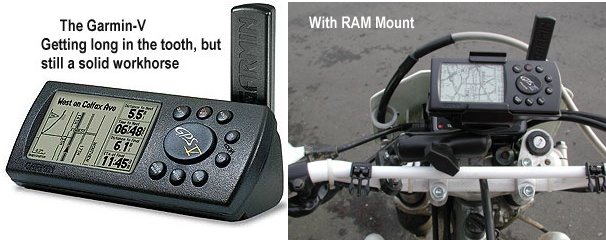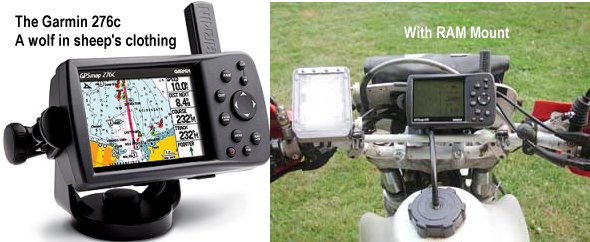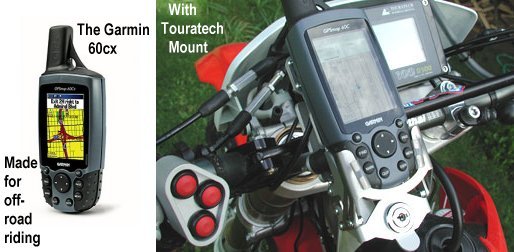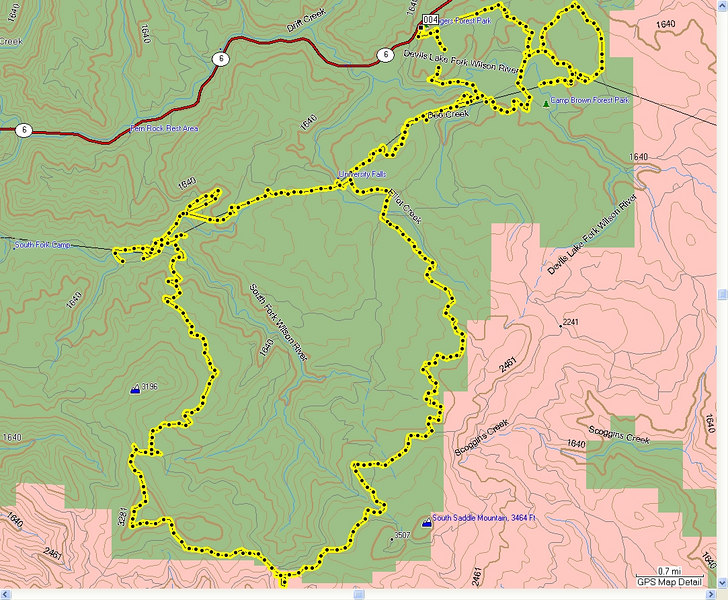
To GPS or Not To GPS - That Is the Question
By Tom Niemela 1/7/07
What’s all this smack about GPS (Global Positioning System) and why the heck should I care? And what does it have to do with off-road riding? I’ve heard this many times over the last few years and I’ve even said it myself. I mean, with a compass and a quality, geographical map, I could always get around pretty good. But with a GPS there are many advantages, some of which are:
…and on and on. I’ll give you a 10,000-foot overview of GPS in relation to my particular experiences. I realize there are other brands out there like Magellan and you just know I’d love to try out a brand called TomTom, but my experiences have only been with the Garmin brand. So although it may look like I’m pimping Garmin, it’s merely my experience. Hey, I wish they’d pay me. J Another note is that Garmin’s technical support is top notch.

About four years ago I acquired a Garmin-V as a Christmas gift. Being the Geek that I am, I was enthralled and intrigued by it. I honestly had no idea what capabilities it would have, but I jumped in like an Acapulco Dive nonetheless. The first concern was where would I mount this darn thing and I heard all sorts of stories of where the best location was, but the general consensus was (duh) on the bars. Everyone steered me towards the RAM mount system and in retrospect that was the best choice. The ability of the RAM mounting system to move its position on your bars is excellent.

The V held four AA batteries for operation, plus it also had the ability to run with external 12v power, should that option be preferred. I always ran with the batteries, since I didn’t really want to add yet more wiring to my dirtbike, but there are advantages, specifically on longer rides. One thing I found out early on is that during rough and extreme terrain, the V would mysteriously turn off and it drove me crazy. I soon found out that the batteries were in a cavity of the V, where two batteries are placed end-to-end with each other in two slots. What would happen is that, while riding through whoops or gnarly terrain, the vibration would, for just a millisecond, allow the two batteries to vibrate apart, therefore killing the juice to the GPS processor – off it went. The cure for this situation was to wrap a small piece of Scotch Tape around where the two batteries connected to each other and end of problem.
The other problem I initially had was that the V would eat up a set of batteries after about four or five hours – pathetic! After Googling the problem, I discovered that I had the WAAS feature enabled on the V, which had the processor continually searching for WAAS locations out in the forest, of which there aren’t any, so it constantly kept searching, slowly eating up the battery charge. WAAS is primarily for aviation correction, is land based and the signal reception is ideal for open land and marine applications – clearly not needed in our forest trails. After turning off the WAAS capabilities, my battery life suddenly doubled/tripled.
After the initial teething pains, I was now catching my stride with this GPS gadget. I began to take this puppy with me on literally every ride. It is SO cool to get home, download the track log to your computer, view it on the screen and see every detail of where you were that day. Try to explain to your buds where you went that day? No problem, bring it up in Garmin’s Mapsource program (the program that uploads/downloads maps, waypoints and track logs to your PC/GPS), view the track log on screen, hit Shift/Print Screen, paste it into your fav picture-editing program like Photoshop, save and email it to your pals. You can also email them the exact track log that you created and they could then take that log, input it to their GPS, and ride the same route at another time - awesome indeed.
I started to also run it while driving my car/truck around also. Whyzat, you ask? The autorouting feature is killer! Need to go somewhere, but you don’t know the exact location, since you’ve never been there before? No problem, just input the address and select either ‘Faster Time’ or ‘Shorter Distance’ and follow the arrows – way cool. You can search and autoroute to the nearest gas station, hotel, restaurant or (for your girlfriend) the shopping mall.
There is a biz up in Washington State called CycoActive (www.cycoactive.com) who specialize in GPS and accessories. The main man, Tom Myers, I’ve known for a number of years, due to his help with the US ISDE Team, plus he’s attended some of my dualsport rides. Tom and his shop were a wealth of information and offer all the goods that we, as dirt riders, need for GPSing. I highly urge you to check out his site and support those that support our sport. Tom and his crew ride – a lot, and know what works and what doesn’t.
After learning all the intricacies of my V, I decided to upgrade and purchased a Garmin 276c unit from CycoActive. Oh baby, was this an awesome piece of machinery, since it had all the bells and whistles, some of which I still do not know all the functions to this day, plus a color screen. The one Achilles’ heel is the size/weight of the unit, which in essence does not make it an acceptable unit for aggressive or advanced riding. But from casual trailing to anything less extreme, it is “da bomb”! The V had only 19mb of memory, but the 276c had the ability to add [proprietary] memory, so I purchased a 128meg card, which allowed me to install almost 10 times more maps into the unit. This GPS is absolutely incredible when out exploring, since the pixel details are very exact and the added memory/features will never leave you lost.

This last Christmas, Santa was extremely good to me and threw down the chimney a spand, branking new Garmin 60cx. I said to myself, “Self, yet another Geek gadget? Does yours truly really need another gadget? Is the Pope Catholic? Are KTMs orange?” I quickly opened up the 60cx box and started perusing through the manual – RTFM (Read The Manual)! I quickly learned that this 60cx would end up being a replacement for my V, since it had unlimited, add-in [microsd] memory (well, okay, 2gig max), a color screen, was small, waterproof, could run an external antenna, worked via USB data cable, considerably more battery life (with only two AA’s) and had a new, sensitive internal-antenna receiver. I’ve only been out once so far with this bad boy, and in a couple words – it rocks!

Don’t want to spring for the high-zoot mountings like the RAM or Touratech (pictured above) mount? No problem, just leave it in your jacket or backpack pocket. It will still work, though the reception may be sub par.
Here’s something I learned back when I first got my V: get yourself an external antenna booster. These little items aren’t very big and manage to keep a lock on satellites considerably better, especially when in canyons or a canopy of trees, like we have so much of in the NW. How I mount mine is with Velcro on the backside of the external antenna, connected to the other Velcro side on the top of my front-brake master cylinder. It gets a good view from there, just make sure and route the wire smartly, so no limbs snag it.

There are a few draconian issues with Garmin, one of which, when you register their proprietary mapping programs like City Navigator, you can ONLY use it on two, registered Garmin units (using the GPS serial number). To use the same purchased mapping program on a third GPS, the user would have to purchase another copy – weak! Another snivel about Garmin is that you can only view one type of map sets at a time, i.e. multiple map types cannot overlap. If you have Topo West, Roads & Recreation and City Navigator maps loaded, you can only choose one of the three to view at a time. Not the end of the world, but a hassle nevertheless. Also be aware that if you ever save your track logs internally to the GPS unit itself, you will lose major details in the track log. If you however download your track logs directly from your GPS memory to your PC, you will retain all the intricate details. Again, do NOT save directly to your GPS if you want to retain high detail – you will end up with a detailed track log that did have tight turns, but is now a straight line! All these whines are fairly easy to work around, if you are aware of them.
Here is one reason I specifically started a few years ago to GPS all the rides that I do: there are many efforts to close off riding areas, whether it’s trails, roads or blocks of land. One of the ploys that some land managers use is that there were no trails in a particular area; therefore the area is slated to be closed. I can easily refer to my archives of track logs and produce exactly where a legacy trail went. The land manager has no leg to stand on regarding this angle. Imagine if everyone GPS’d their rides and we all pooled our track logs together in a library of sorts, then we would be able to present the routes in a statewide book or online offerings to riders visiting our state or just us visiting other riding areas (like the picture below of Brown’s Camp).

If you’re not afraid of straying away from the MX track or staging area, love exploring and telling others about your travels, a GPS will be one of the single, best investments you will ever make. Since I’ve been hooked, I honestly don’t know how I got along without one. There is a veritable plethora of sites on the internet with a wealth of information about GPS systems ranging from geocaching to product reviews and yes, Martha, even motorbike GPSing. Check it out and you’ll be hooked too!
UPDATE 1/27/08: I've sold my trusty old V and now only run my 276C in the car and the 60CX for everything else. I have to say that the 60CX STILL impresses me - along with my friends who bought one too! I have NEVER lost satellite reception with that bad boy, except going through a tunnel. Its stock reception makes my 276C (with external antenna booster) look pathetic by comparison! I have a few friends that got the 60CSX and they feel that the added 'sensor' feature of the CSX is probably not really worth the extra $50, FYI. The ONLY problem I've had with my 60CX is it shutting off due to vibration while racing/riding, but this can be resolved by careful placement of silicone or foam inside the battery case, or just hardwire it to your bike. If you ride (off road especially), hike, mountain bike or just do a lot of travel - the 60CX is the GPS for you!
UPDATE 3/9/09: I have now sold my 276C and replaced it with a 60CSX. The 276C was an excellent GPS, but missing one key feature: Garmin's SIRF antenna, of which the 60CX/CSX have. The 60CSX is identical to the 60CX, other than the 'S' feature, which stands for Sensor. This is used for Garmin's compass while stopped. That feature works great, except you have to recalibrate the compass sensor often. I haven't really used that feature much, but my understanding is that the 60CX is no longer being sold - just the 60CSX. I've also purchased a Garmin Nuvi 750 for the car, and a Garmin Nuvi 500 (waterproof) for my road bike. They are larger displays and touch-screen featured, but they have nowhere near the capabilities of the 60CX/CSX for tracking (they do have the important SIRF antenna though!). I continue to believe that Garmin's 60CX/CSX units are the best for us off roaders!